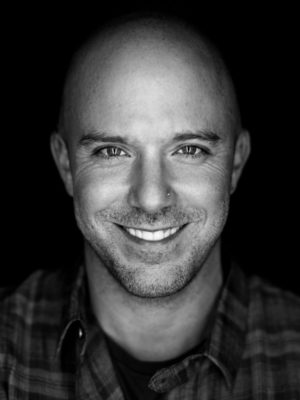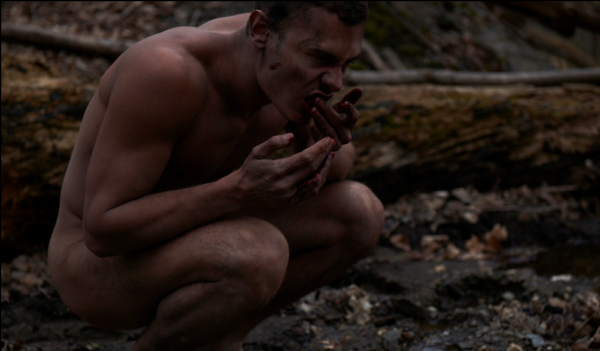 Name: Carter Smith
Name: Carter Smith
Age: 47
Birth Place: Bowdoinham, Maine
Sexuality: Gay
Notable films: Bugcrush (2006), The Ruins (2008), Jamie Marks Is Dead (2014)
When did you know you were queer? When did you come out?
Carter Smith: I always knew I was different. That didn’t necessarily mean gay or queer or anything to do with sex until it was given those labels by someone else. I’m from a small town in Maine and I definitely felt like I was unlike my classmates. I was being called a faggot before I understood what that even meant. And once I figured it out, I realized that if that means that I like boys and want to kiss them and see them naked, then – yeah – I’m definitely one of those.
I don’t really have a big “coming out” story. I was open with my friends and family and they were great – really loving and supportive.
How did you get into filmmaking?
CS: My first stories were all told with still photography. I grew up without a 4k camera phone in my pocket and “film” (as in moving pictures) seemed so far away and un-attainable. I DID have a 35 mm stills camera and I would come up with elaborately staged stories (usually creepy) that I’d storyboard carefully. I would make costumes and props, then force my younger sister and her friends to be my models. Sometimes this would involve a gothic ritual in the fields behind our house. Sometimes it was decapitated doll heads floating in a blood-filled toilet.
I moved to New York City when I was 17 and wound up a fashion photographer. It was fun for sure, but after a while I was like – I’ve ALWAYS wanted to make films, so why am I not doing it? That’s when I did Bugcrush. When I read Scott Treleaven’s story in the amazing anthology Queer Fear I knew straight away that it was going to be my first film. It was strangely romantic. It was horrific and creepy and so fucking dark. It was queer. It was perfect.
I’d been working with an amazing crew of creatives on my stills work, so it all came together quite quickly. We shot at my high school in Maine and I paid for everything out of pocket. And then the best case scenario happened: we got into Sundance and Bugcrush won best short.
As a horror creator, what is it about horror that attracts you?
CS: I’ve always loved horror. The thrill of being frightened – the physicality of it. As a kid it seemed like there were a lot of outsiders in horror, and I definitely identified with that.
Growing up in Maine I also read a LOT of Stephen King. He was the one who made me fall in love with the storytelling part of horror. I also think ending up in fashion cemented my love of horror. I spend most days making “pretty” pictures, which makes me crave the dark and disturbing all the more.
What films (queer or not) have made a significant impact on you and your work? In what way?
CS: So many! I grew up in the VCR age and devoured every slasher and Italian zombie flick that I could get my hands on. We would always stop by the video store before picking up my sister from ballet. One day, a mother of one of the other kids slipped me a VHS tape. “I heard you like horror movies.” she said. “You might like this.” It was just a tape. No case. No label. It ended up being The Brood, and for the first time, I remember thinking that horror didn’t have to be ugly and cheap and garish. It didn’t need to have a crazed maniac stalking horny teenagers to be scary. I was into all the sex and cute boys in the final girl films, but I was mesmerized by The Brood.
My Own Private Idaho was probably the first “queer film” that I remember seeing. Everything about those two (Keanu and River) was perfect to my teenage self. I also saw a double feature of Betty Blue and Rivers Edge when I was maybe 14. I remember thinking that both of those films had such singular, clear visions behind them. The stamp of their maker. It was probably the first time I was aware of film being a director’s medium.
You’ve made independent films, as well as studio fare (the criminally underrated adaptation of The Ruins). How progressive or welcoming is the industry for queer creators right now?
CS: Queer. Straight. Whatever. I think it’s about figuring out how to tell your story in a way that audiences connect with. I feel like the industry is pretty inclusive of anyone who’s able to do that.
You’ve made some very explicitly queer films, including Jamie Marks Is Dead and Bugcrush, a personal favourite that freaks me out so much I wrote about it with Trace Thurman in our Horror Queers series. How does your sexuality inform your films?
CS:I don’t think it informs my work any more than it does for any filmmaker, though I guess it affects the types of stories I’m drawn to: stories about struggling to connect and what it feels like to be an outsider.
What I discovered with Bugcrush was that those aren’t necessarily “gay” themes. The number of middle aged (not gay) women and straight guys that loved that film really surprised me. I thought I was making this strange little dark movie that maybe 50 people would see. But I guess there’s something universal about wanting someone/something you know you should probably steer clear of that connects with a lot of people.
Do you subscribe to queer readings of your films?
CS: Sure!
Have you interacted with many queer horror fans of your work? What has that experience been like?
CS: When I went to a few horror conventions with The Ruins, I remember seeing this group of boys wearing black hoodies. They were definitely watching me, and when they finally approached, I saw that they all had twine pendants around their necks – at the end of each was a small metal bug made of twisted wire. They were dressed like Grant from Bugcrush, and had made their own versions of his bug necklace! I actually have no idea if they were queer or not, but it was pretty fucking amazing.
Jamie Marks Is Dead and Bugcrush both played at a bunch of gay festivals and audiences were generally great. I did always feel like neither of them was quite ‘gay enough’ for some of the audiences, but I think that’s more my own hangup. A lot of traditional queer films are about being gay and I never felt like my films were about that. That’s definitely part of the stories I’m drawn to, but not usually the whole story.

Thiago from All The Dead Boys
You’ve been working with Keith Urban the last few years, but I wanna know when we’re going to get some more amazing horror content from you! What do you have coming up?
CS: You should check out All The Dead Boys. I have this whole other life as a fashion photographer which is basically my “day job”. It’s definitely the flip side of my horror projects as it’s all happy and pretty and really “easy” on the eyes.
All The Dead Boys is a personal project that I started to get back to what I loved about making pictures. A one on one collaboration with my subject without a client or publicist or editor looking at a monitor somewhere behind me. I’d also always wanted to play around with SFX makeup, so I started taking portraits of guys to try things out. Rashes and scrapes. Piercings and strange growths. Horns. A set of teeth.
All The Dead Boys is queer fear at its darkest (and sexiest). The images are cinematic and disturbing and the guys are usually naked. They’re meant to fuck with your perception about what sexy looks like; that line between beautiful and horrific. It’s been mostly stills so far, but last year I did my first All The Dead Boys short film, Sucker, which was a blast. It took more than two people, but not by much.
Allthedeadboys.com is currently getting a bit of a facelift, but should be ready soon. In the meantime you can follow along on instagram @all_the_dead_boys
Follow Carter on social media:
